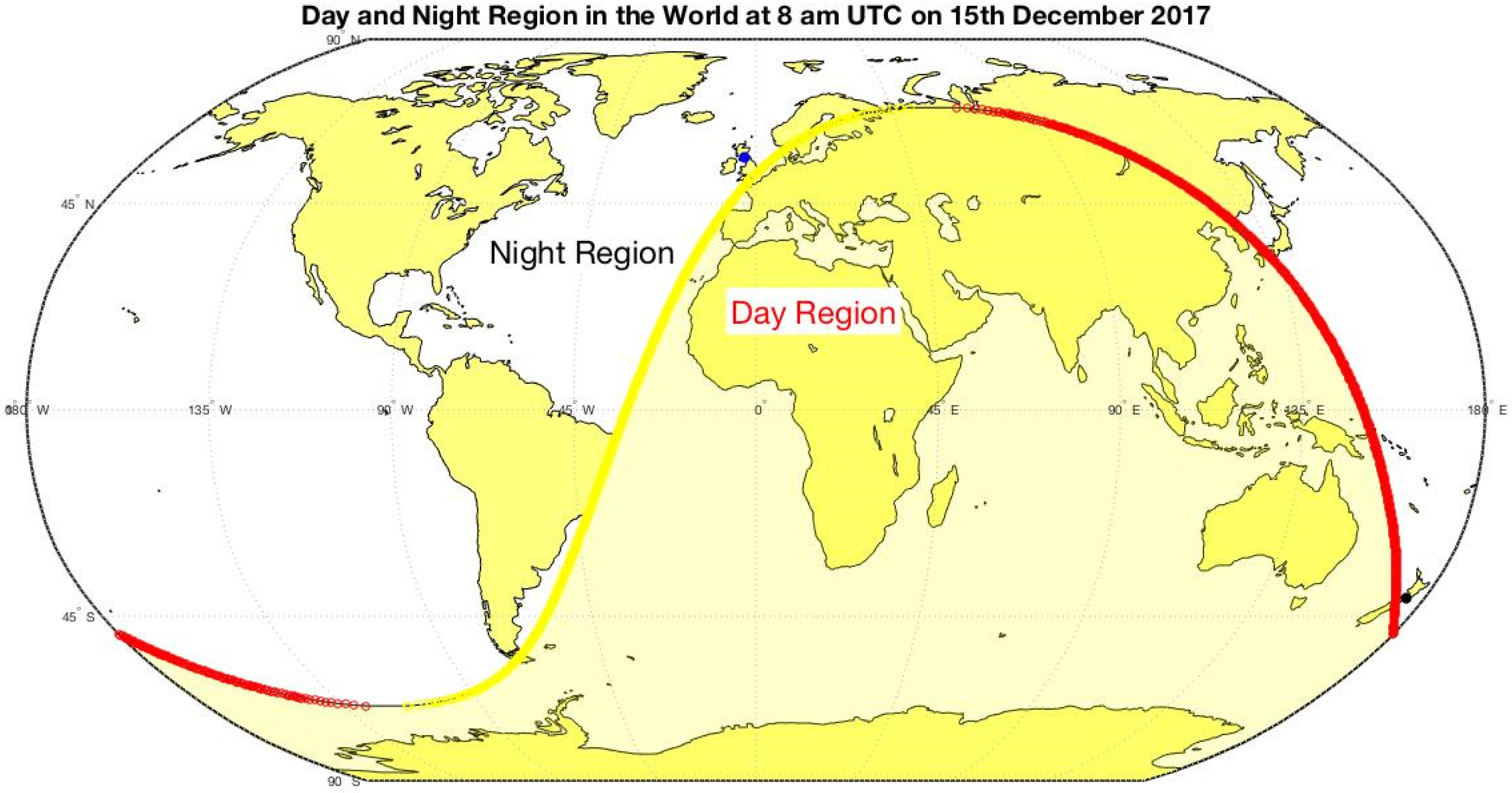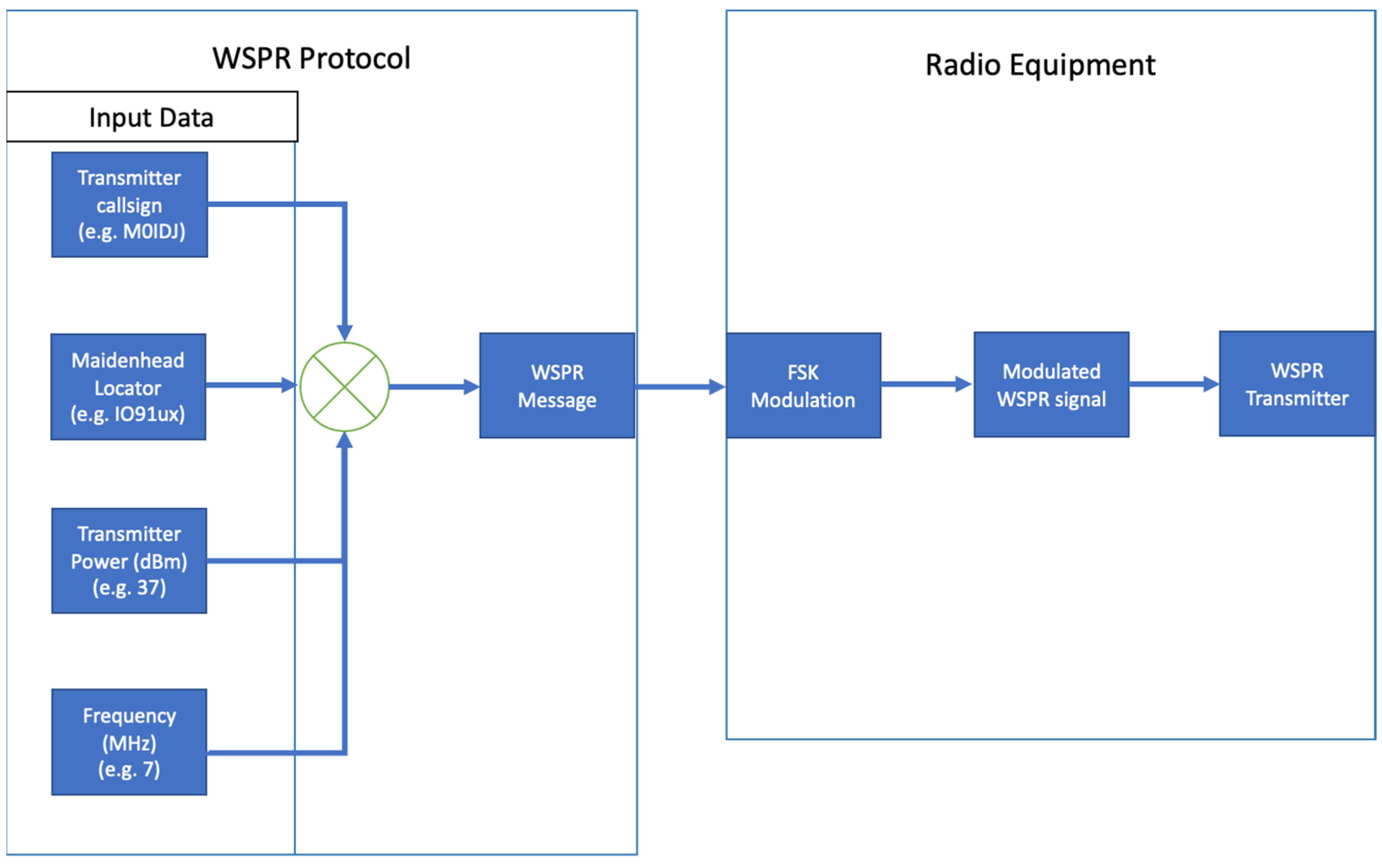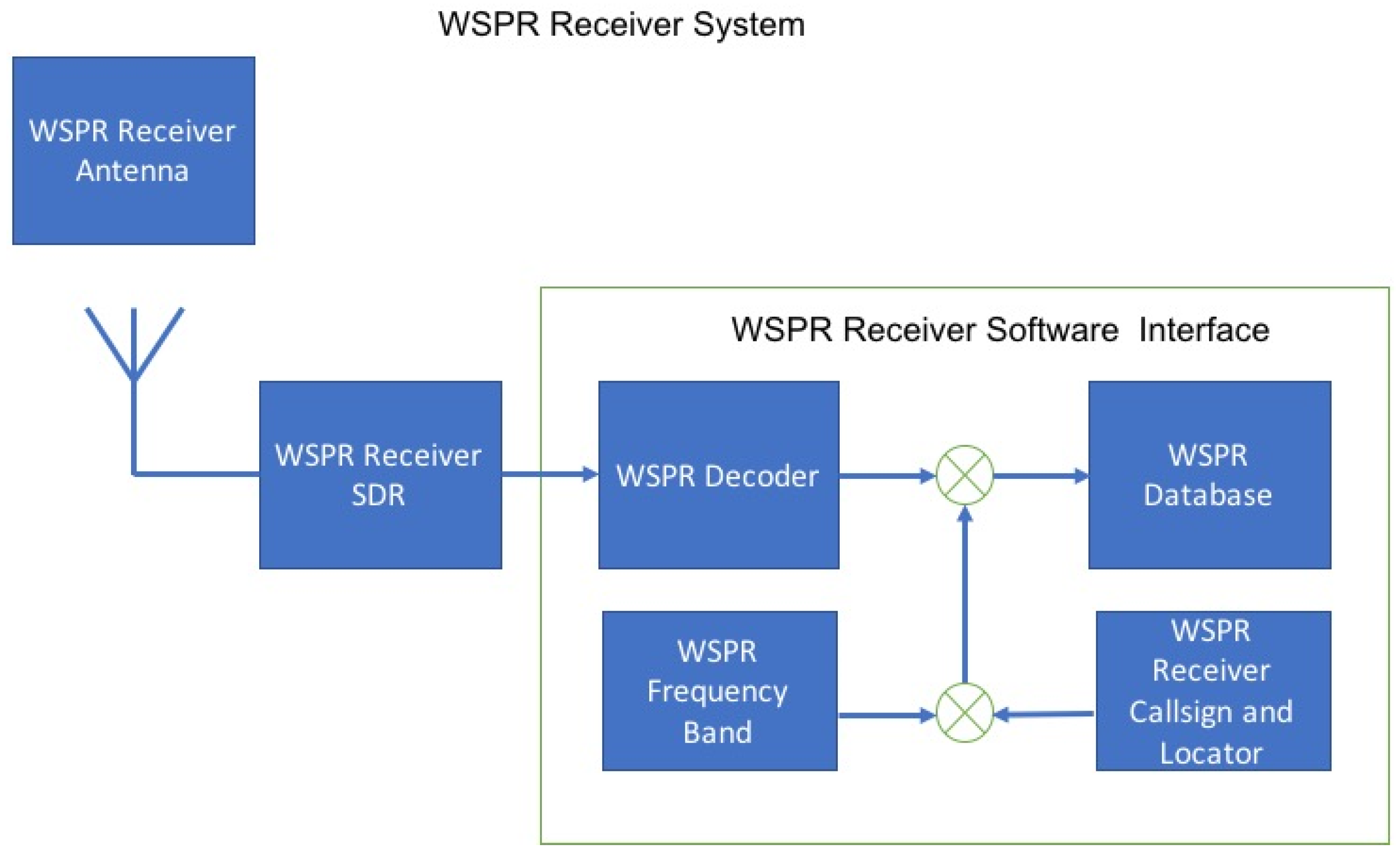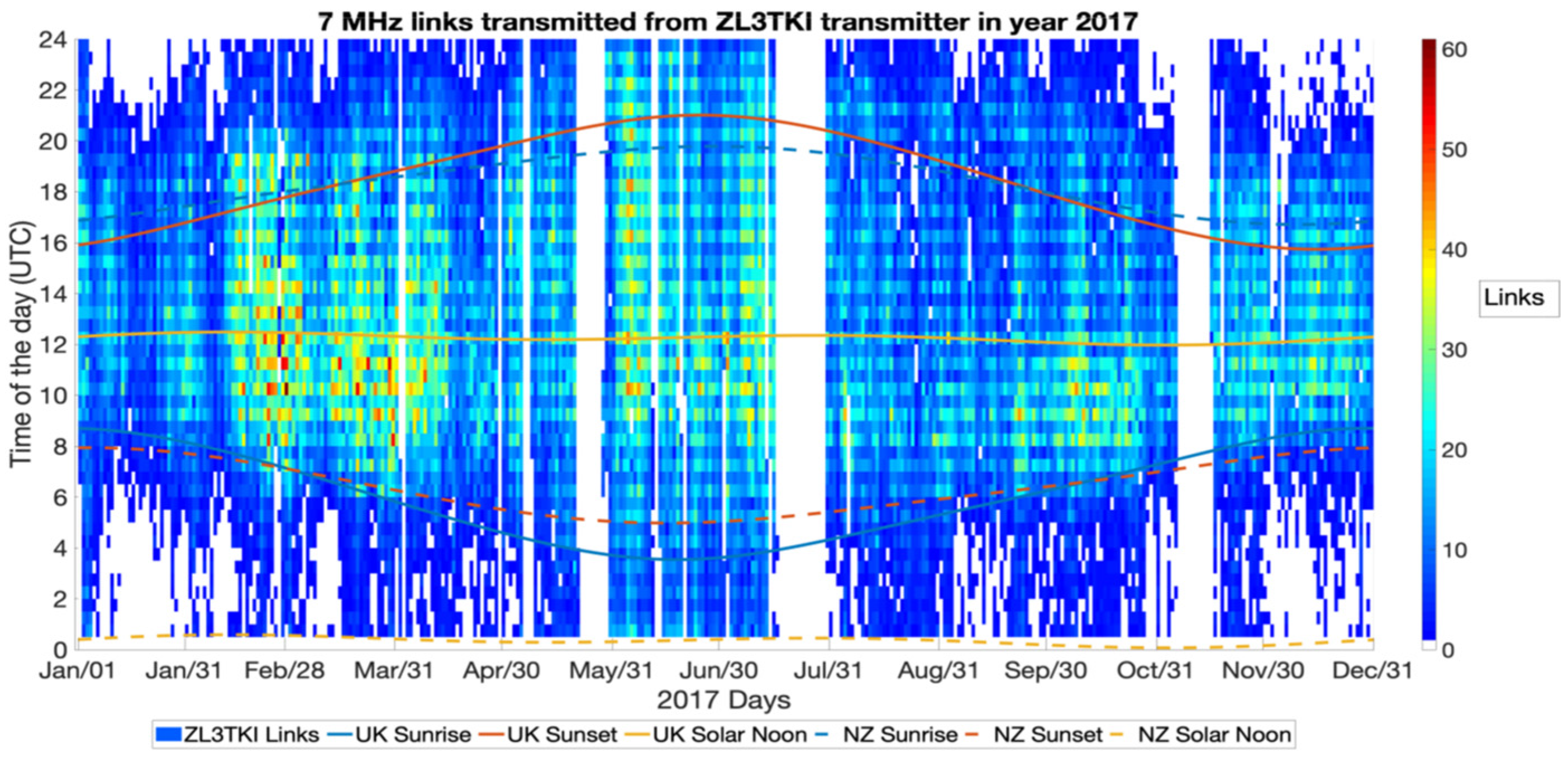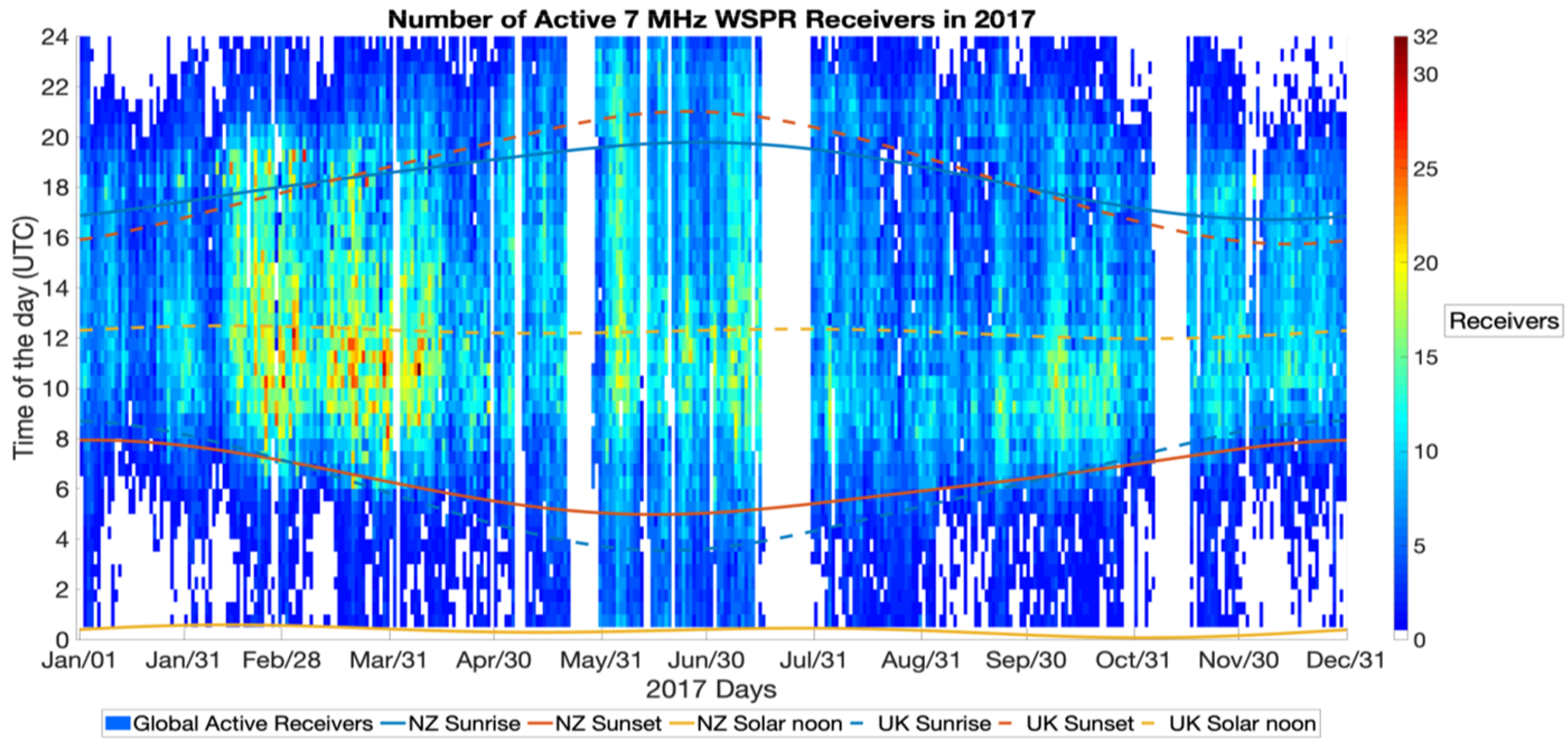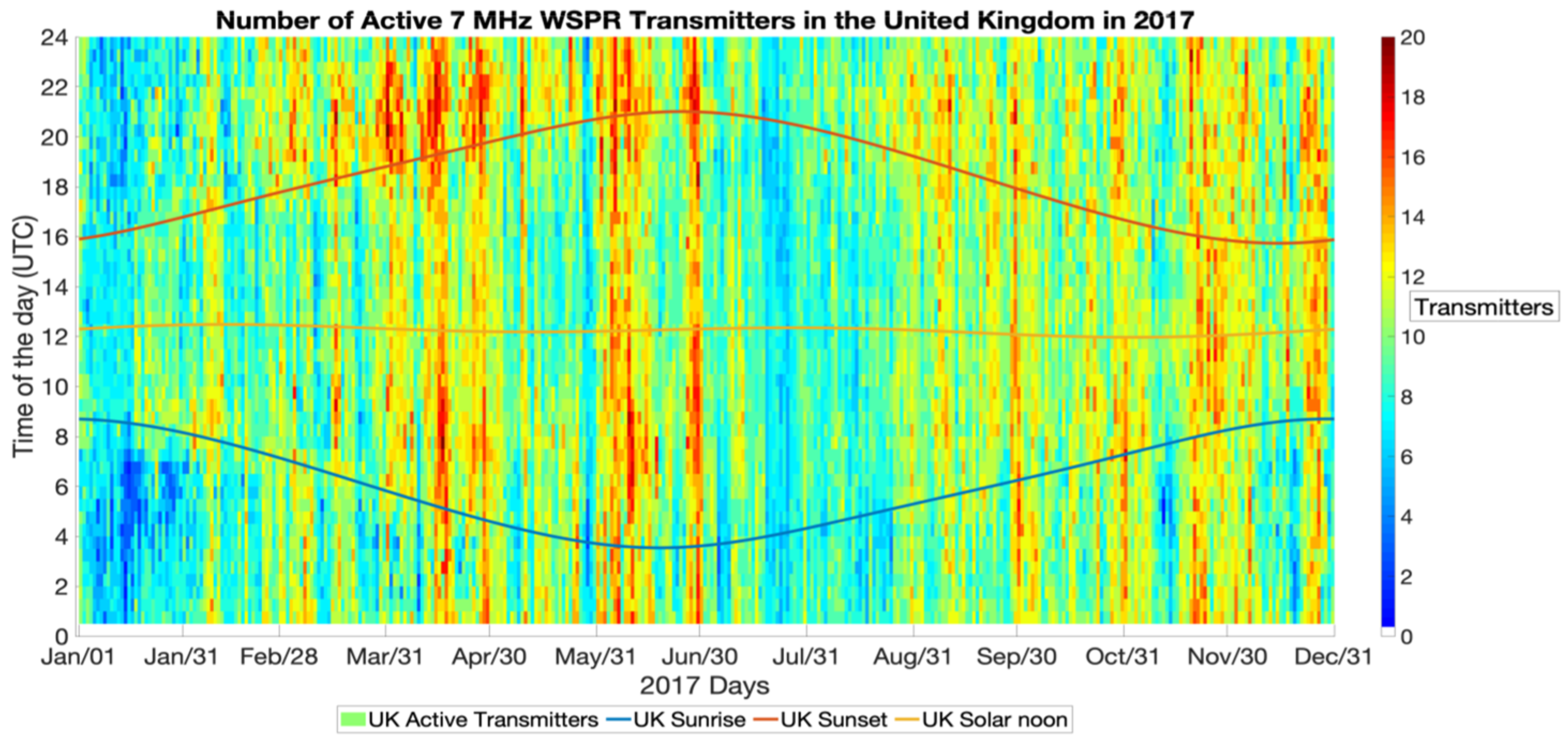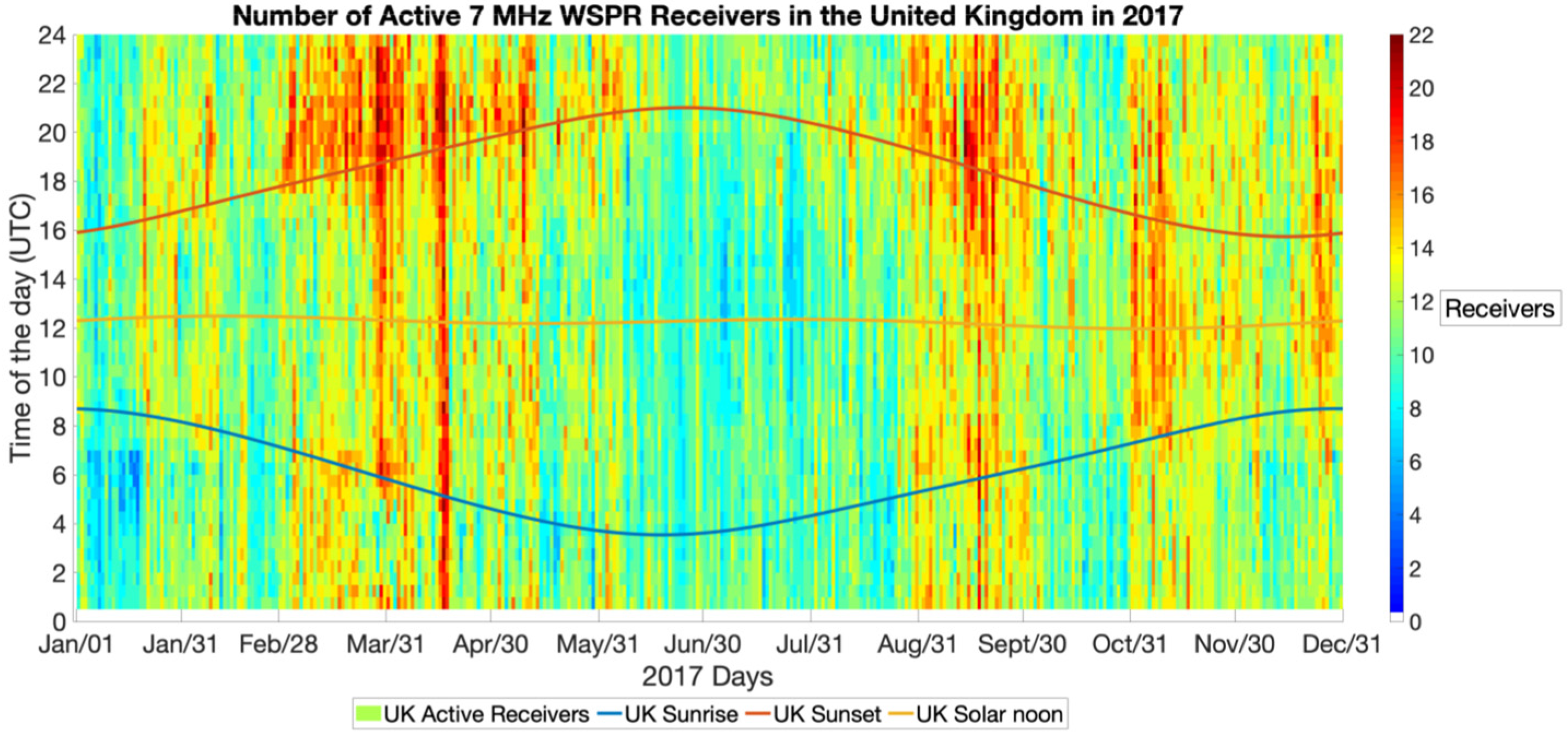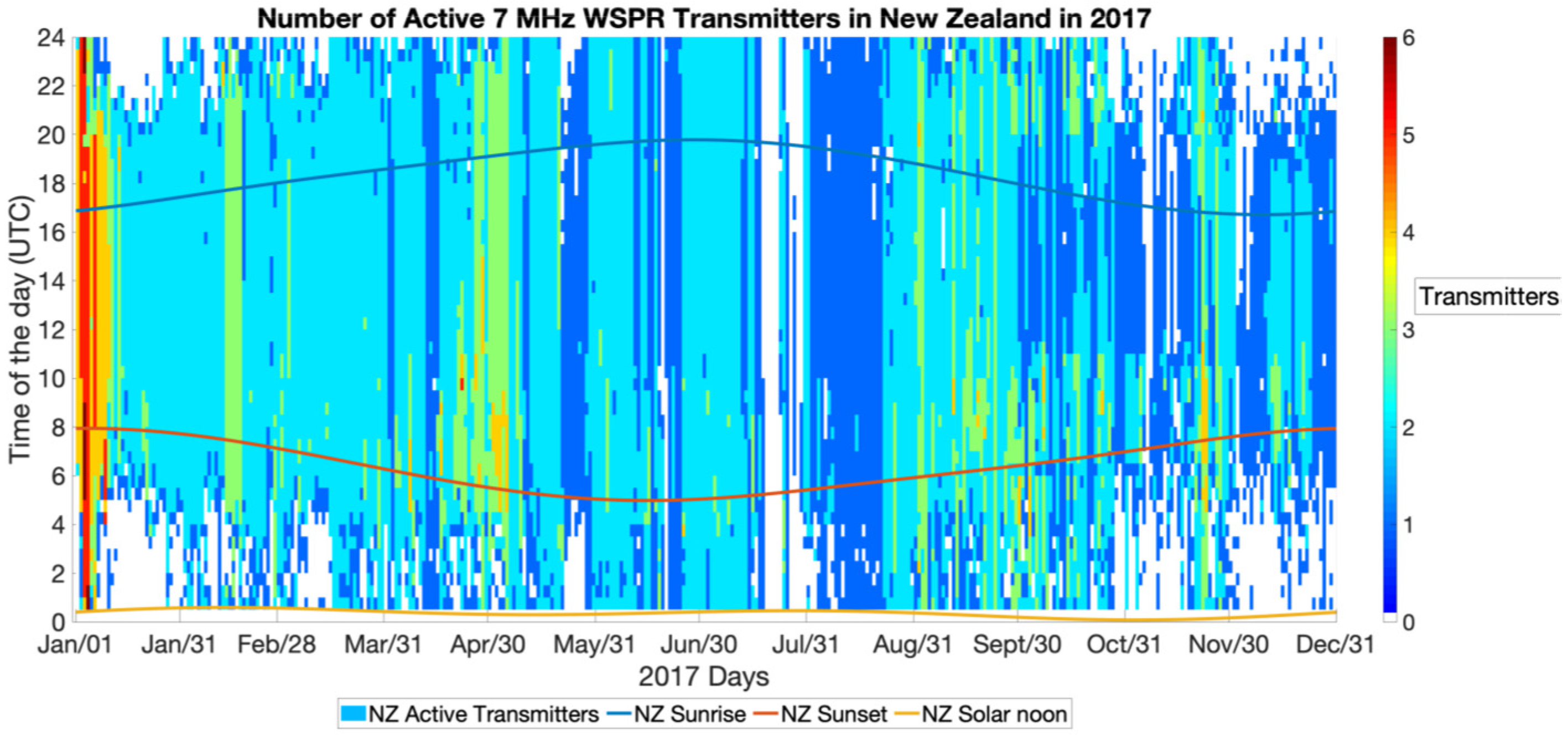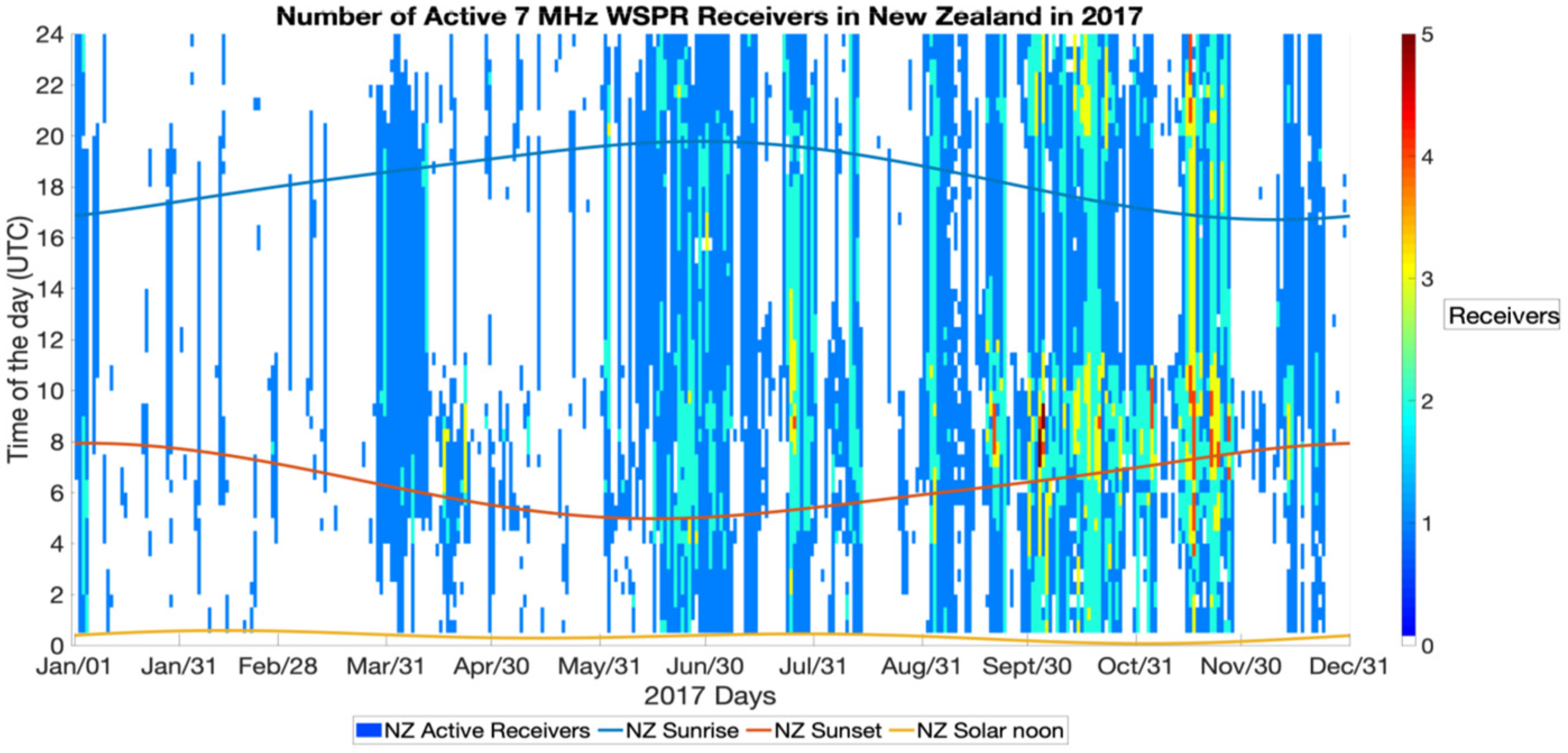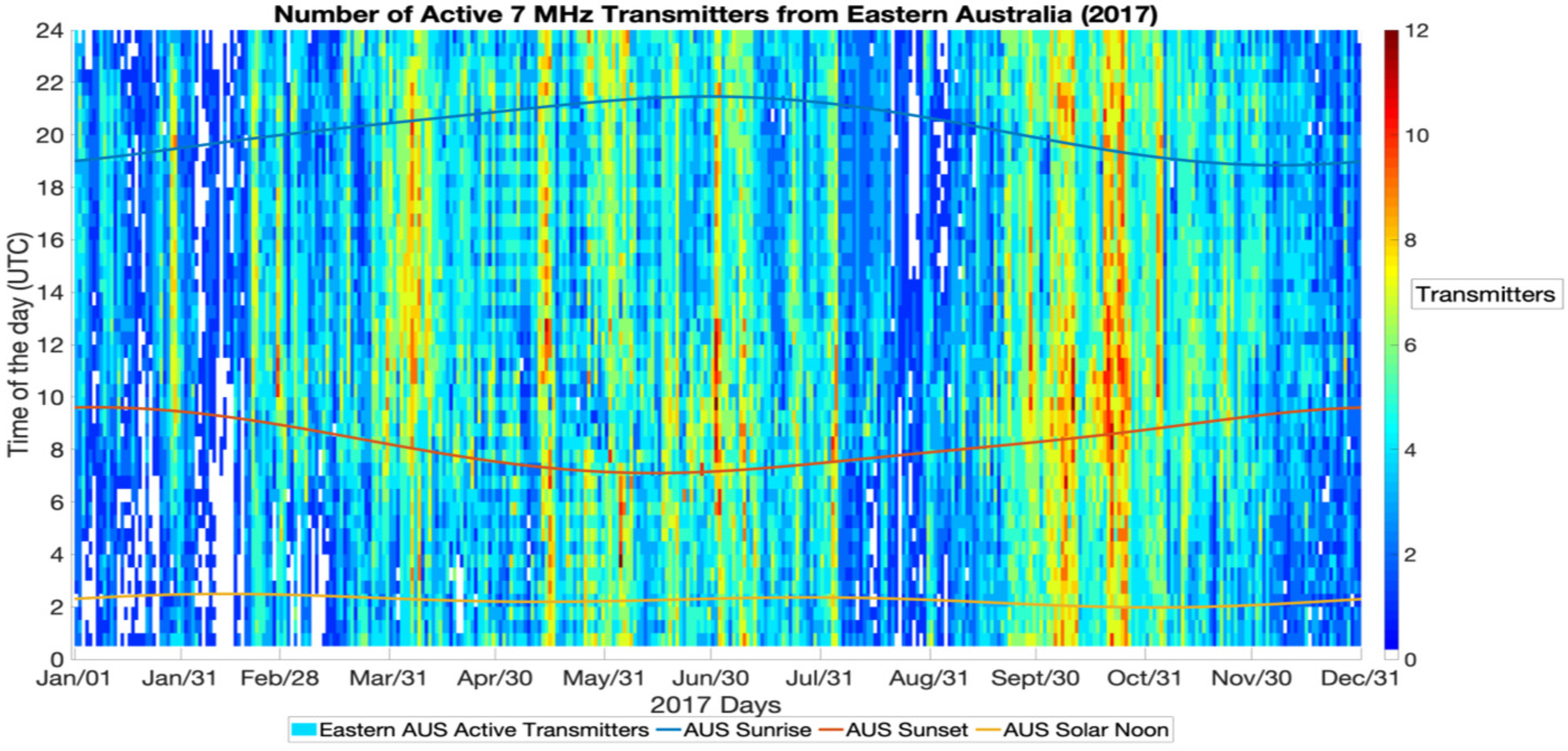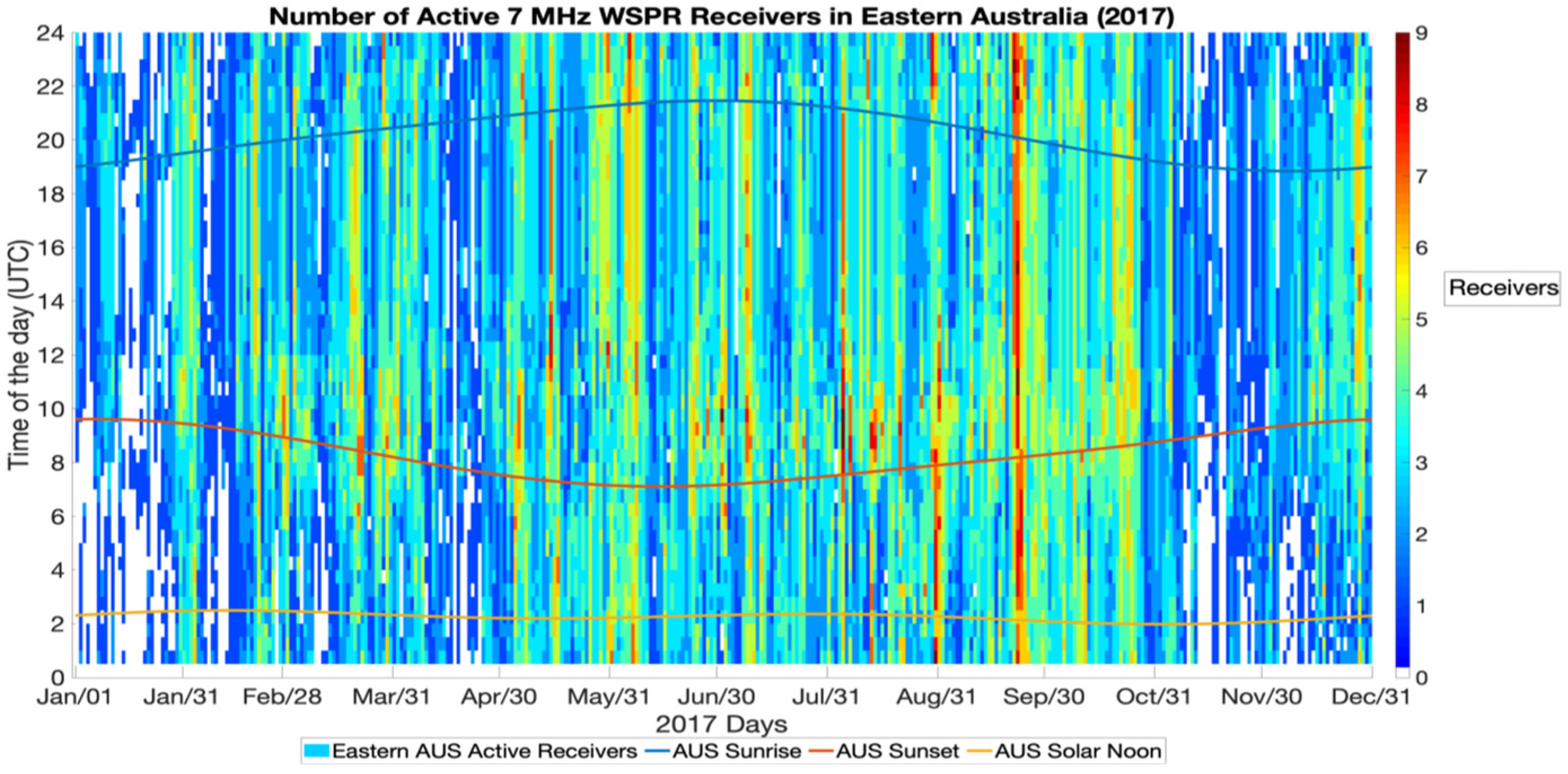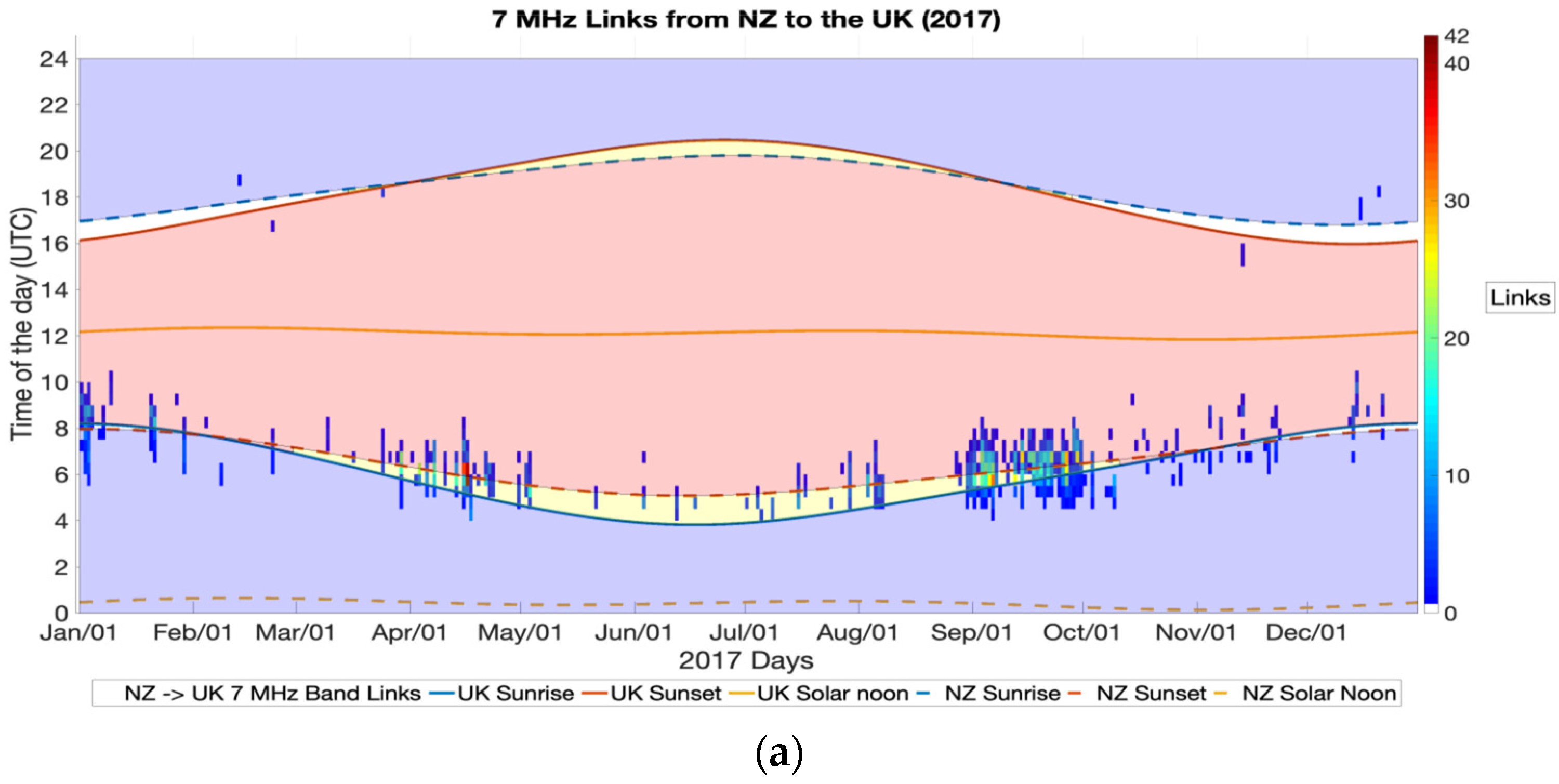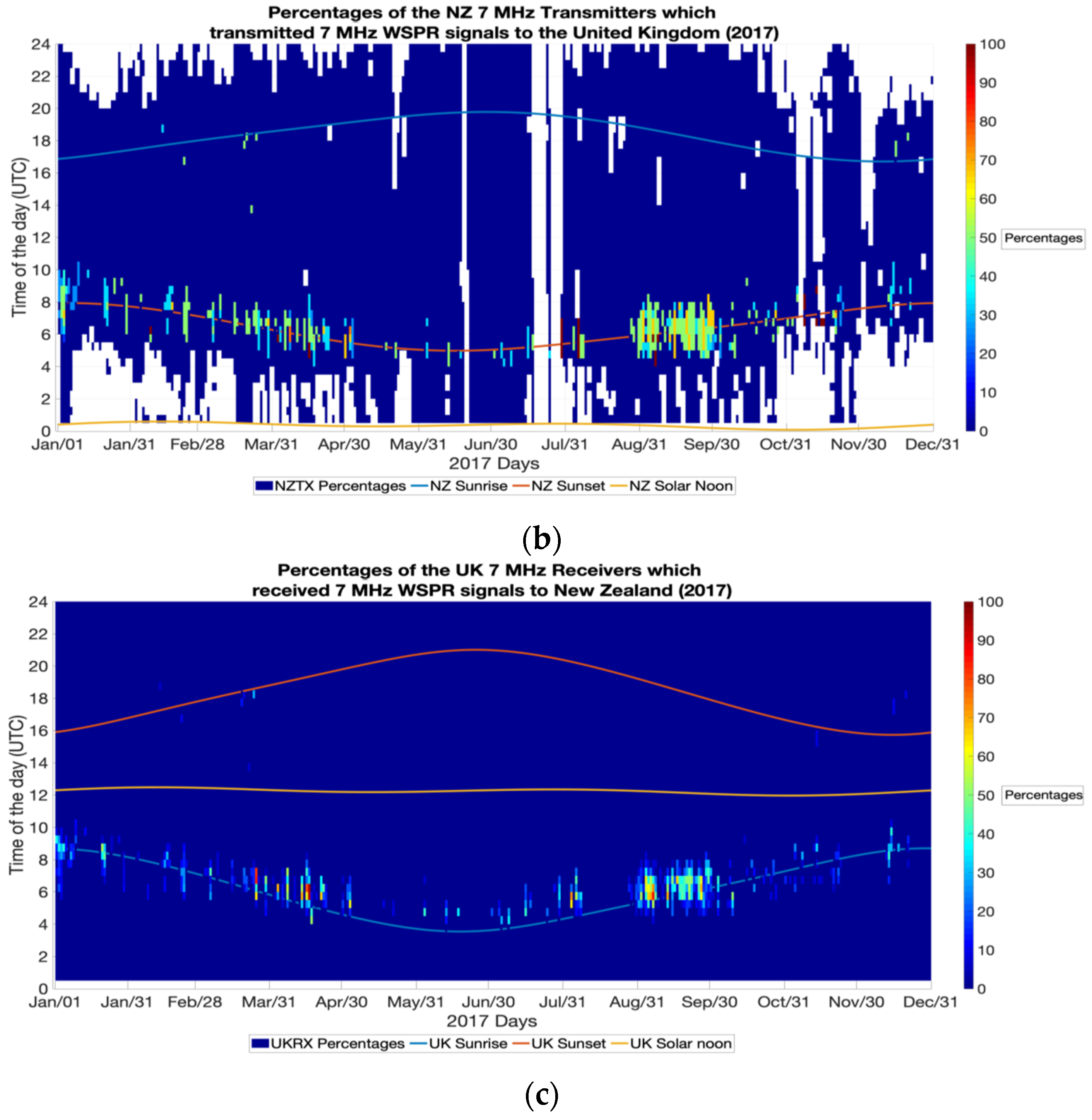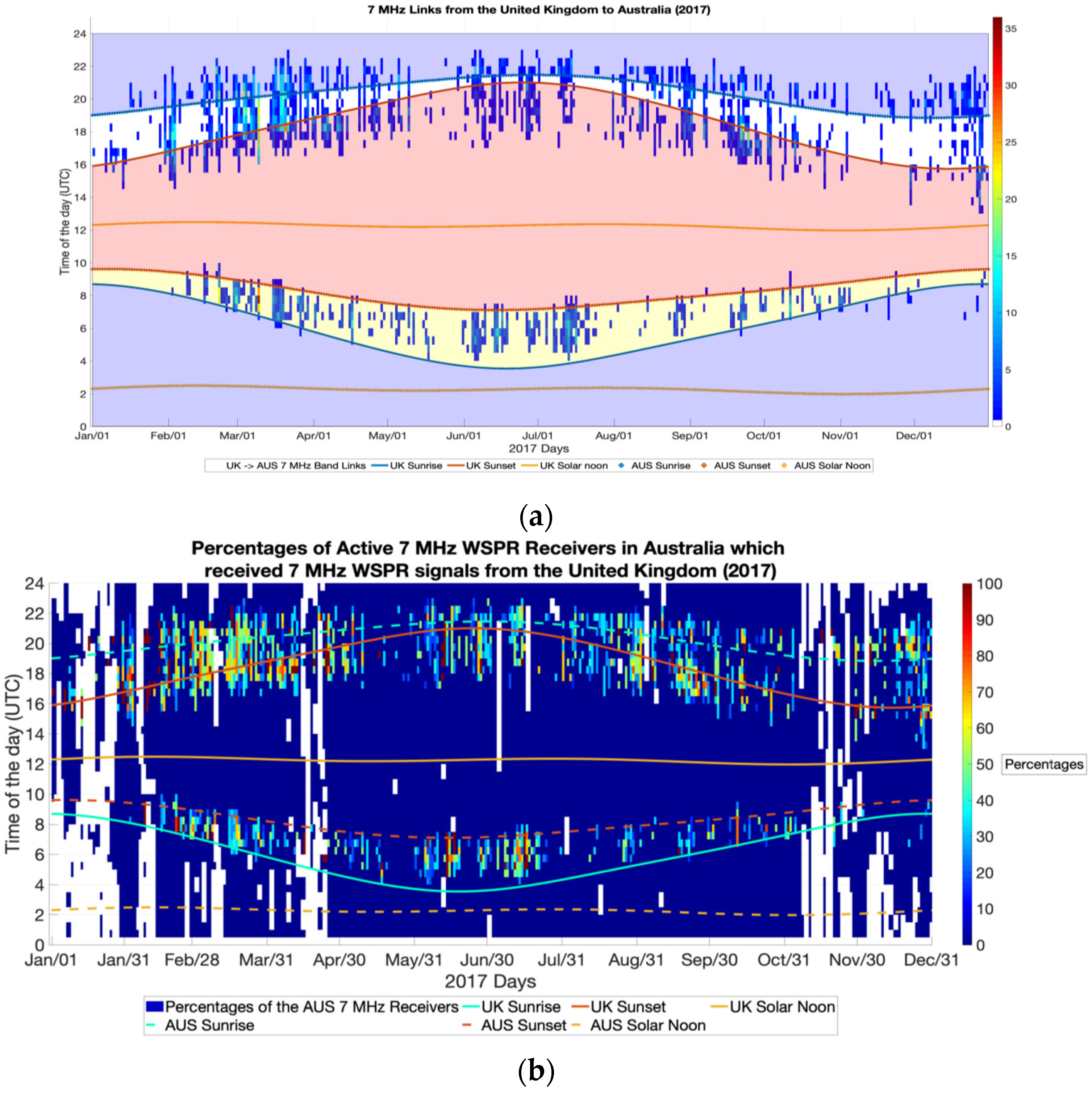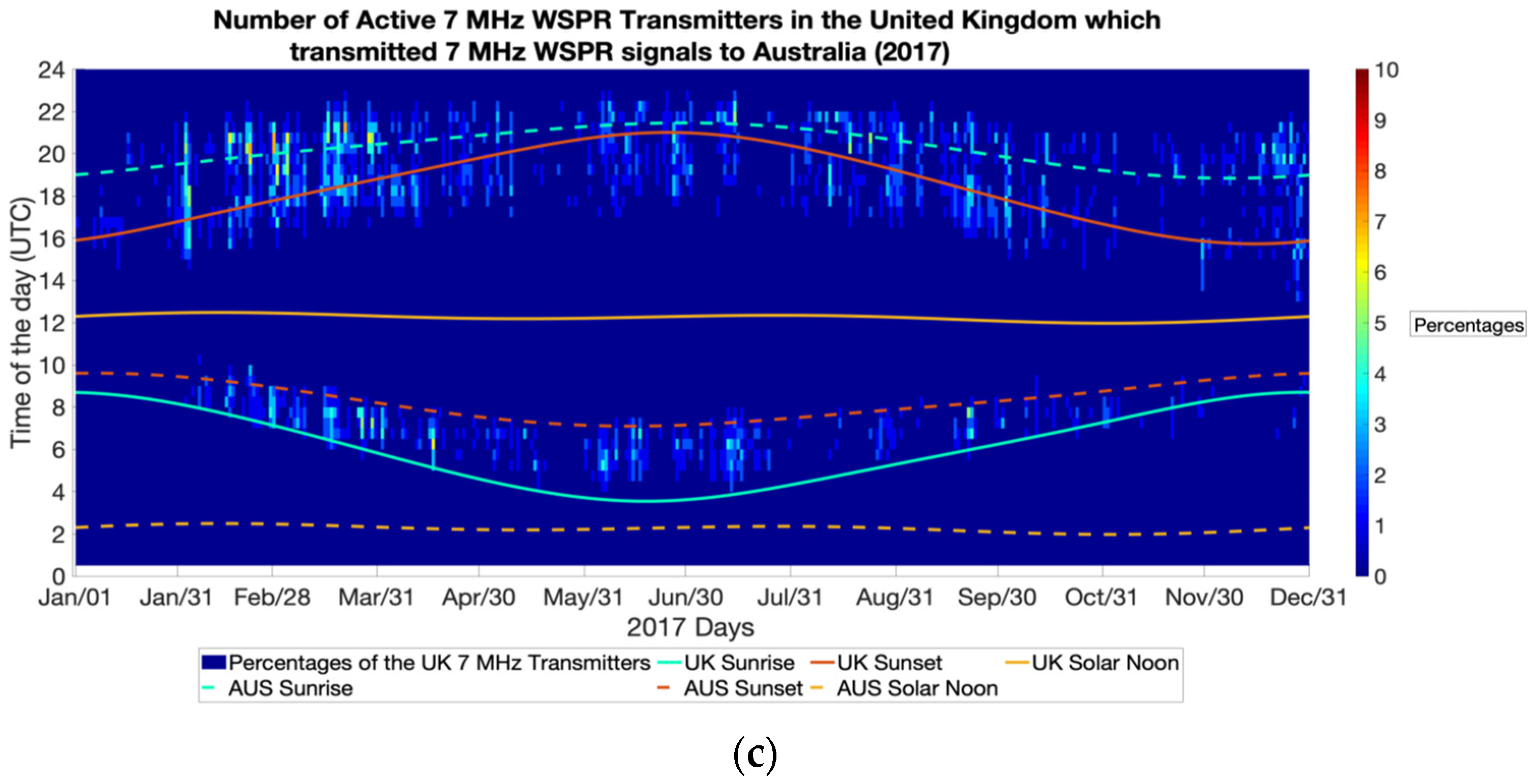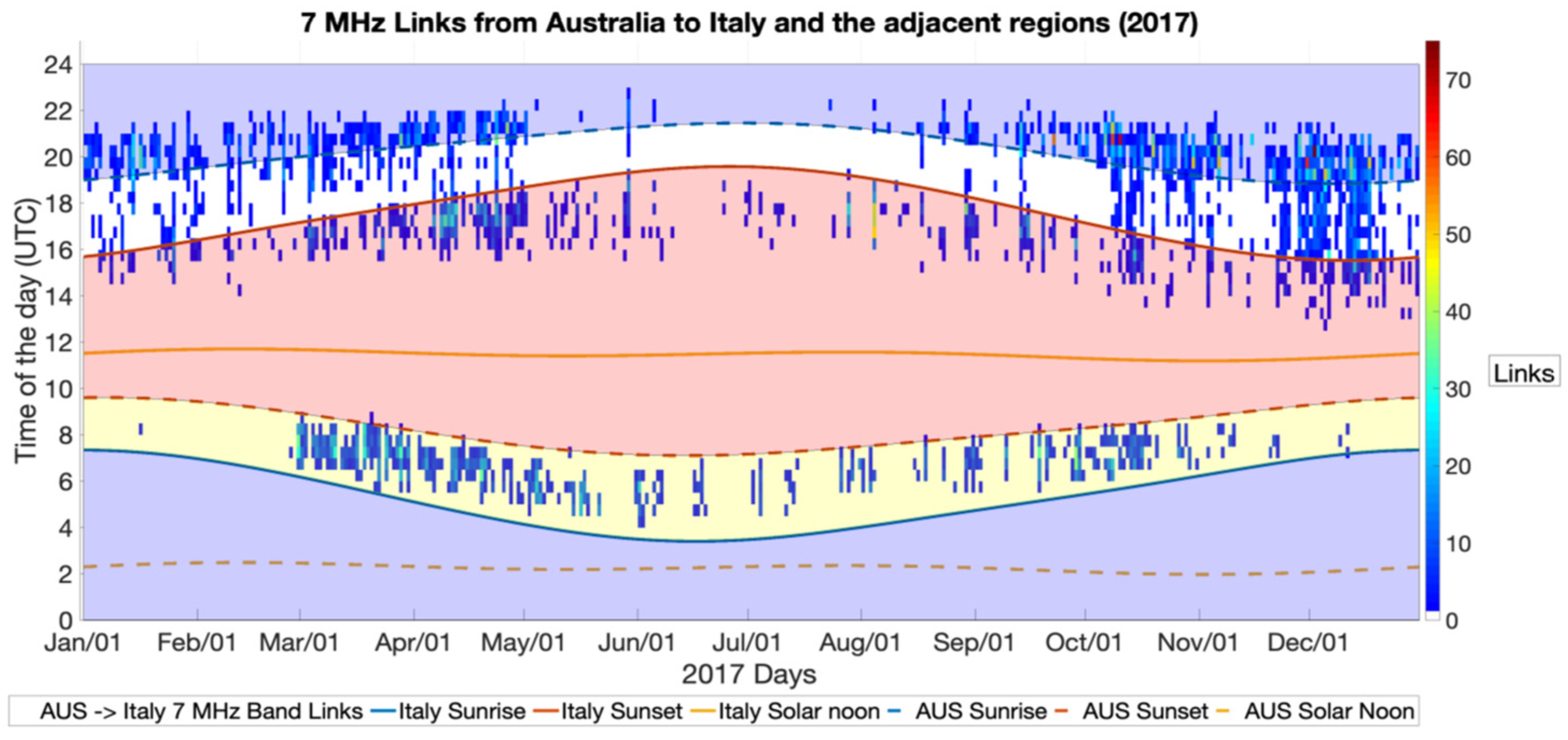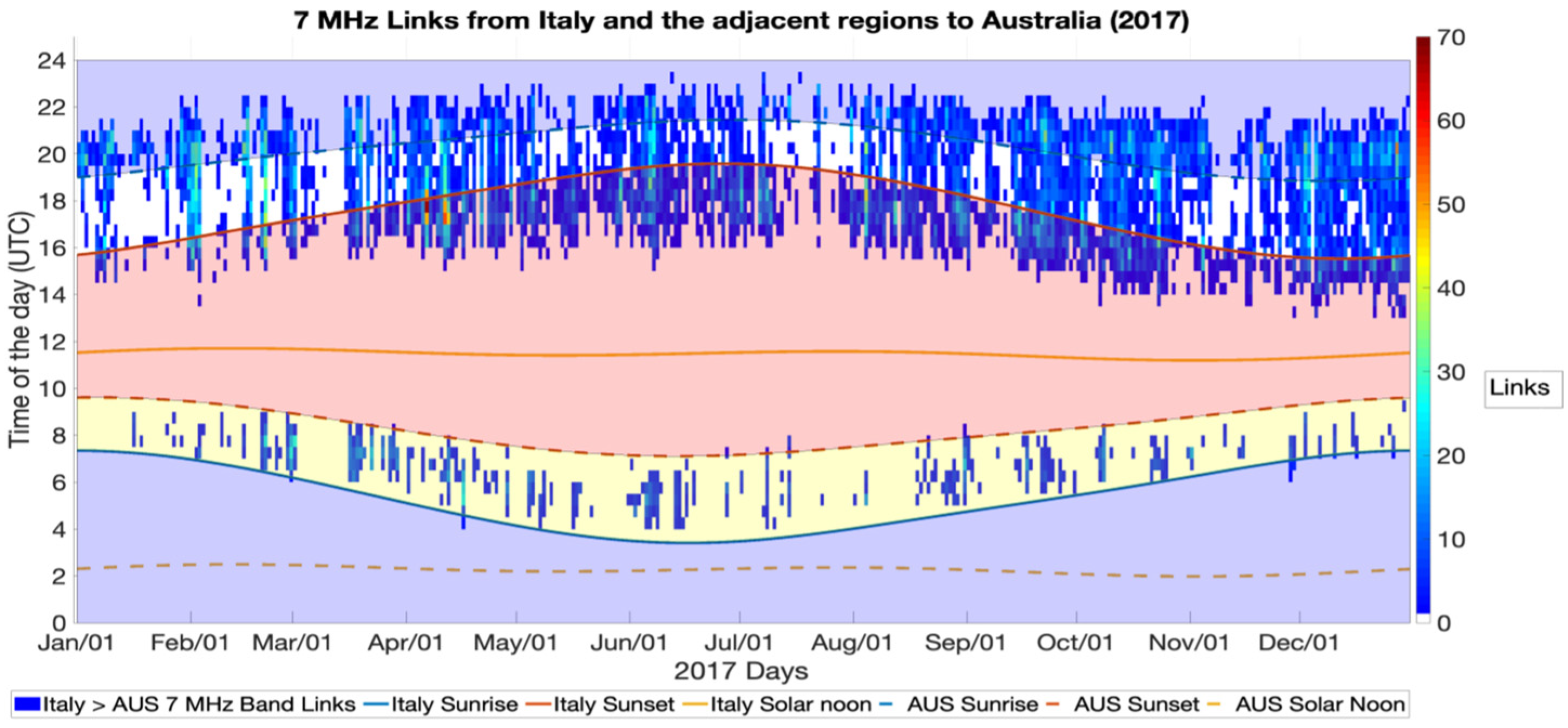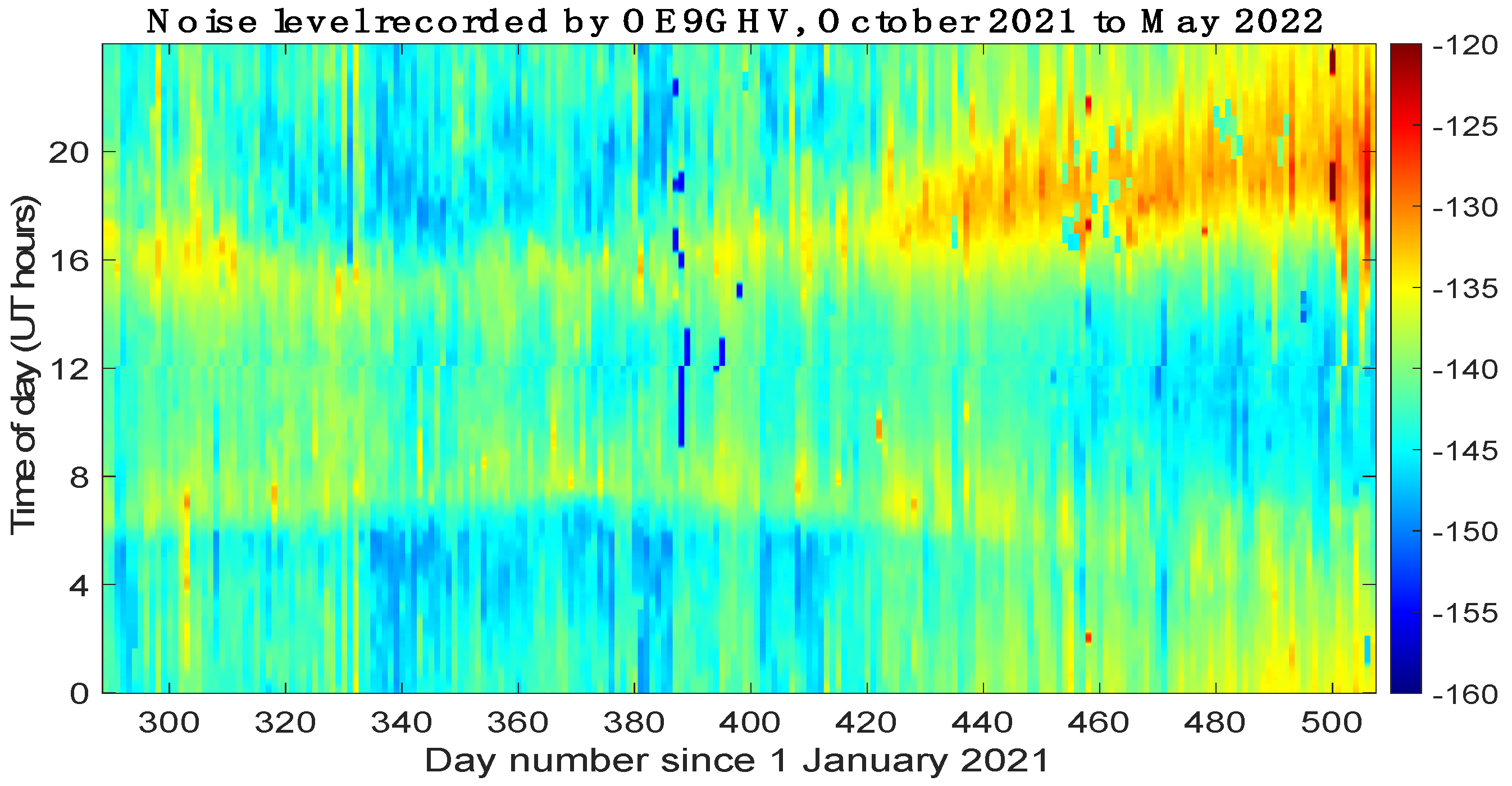1. Introduction
Long-distance high-frequency (HF) radio signals propagate by reflection and refraction through the ionized region of the upper atmosphere, the ionosphere. The ionosphere is a dispersive medium, and its variability results in different HF frequencies being supported at different times, when considering a fixed location of the transmitter and receiver. The refractive propagation of HF radio signals through the ionosphere is dependent on the spatial electron density distribution and the geomagnetic field [
1]. While the geomagnetic field is generally well characterized by a model, the electron density distribution and concentration is quite variable; therefore, the challenge of predicting the propagation at HF is generally limited by our ability to predict the instantaneous spatial electron density distribution in the ionosphere.
For very long-distance paths, such as between New Zealand and the United Kingdom, which are close to being antipodes, there are persistent reports that the radio wave propagation is significantly enhanced at dawn and dusk. This is known amongst the amateur radio community as “greyline propagation”—propagation of the radio signals along the terminator or simply entering the ionosphere and exiting the ionosphere at the terminator (sunrise/sunset) times (see
Figure 1). An early reference from the
Amateur Wireless magazine notes the propagation on wavelengths of 80 m and 95 m between the UK and New Zealand to be “best between 6.30 am and 7 am”, and they note that this is thought to be “because of the overlap of dawn and dusk” [
2].
Interest in greyline propagation has lasted for over a century. It has been consistently reported by the amateur radio community (for example, [
3,
4,
5]). A report from Callaway [
6] shows radio communication links propagating between Florida and the Cocos Islands (near Sumatra) at a frequency within the 3.5 MHz band (80 m band). This communication link was interpreted to be greyline propagation because both locations were simultaneously located along the terminator [
6]. Pontyatov et al. [
7] presented research on super long-distance and round-the-world propagation in the HF bands communicating between various locations such as between Alice Springs (Australia) and Rostov-on-Don (Russia), and between Cyprus and Rostov-on-Don, using oblique ionospheric sounding. They indicated that the azimuthal angle of 10 to 25 degrees with the terminator is best for making a terminator propagation link.
These reports provide a motivation to conduct a more systematic long-term study. A new opportunity has arisen using the automated collection of radio amateur signals from the Weak Signal Propagation Reporter (WSPR) network [
8]. The WSPR beacon network consists of thousands of beacon transmitters and observers, distributed over the globe with a prevalence in the northern hemisphere. The WSPR database is a very useful resource for radio science as it records the date and time of links made between two radio stations, as well as the callsigns and locations.
This paper aims to investigate the statistical pattern of long distance 7 MHz propagation between two countries that are coincident on the terminator line—the United Kingdom (UK) and New Zealand (
Figure 1). Further observations between other locations such as Eastern Australia and Italy are included to augment these findings and to provide further insight.
It should be noted that due to the nature of amateur radio, much of the information available to scientists describing the amateur systems and data sets is not available in refereed scientific literature. Every effort has been made to reference technical reports as and where appropriate, but there is an inherent challenge in using amateur data for scientific studies. This aspect is discussed in the later sections of this paper.
2. The WSPR System and Data Set
The WSPR system consists of a large number of automated beacon transmitters and beacon receivers that are operated by radio amateurs around the world. Both the transmitters and receivers use the software-encoded WSPR radio protocol. Each transmitter sends out a coded message and each receiver reports the beacons it receives to a centralized database on the Internet, the WSPR database (wsprnet.org, accessed on 2 August 2022).
2.1. Beacon Transmission
The WSPR signal comprises a message carrying the callsign, locator and transmitter power (input by the user within a total of 50 bits) which is encoded using Forward Error Correction (FEC) and interleaving [
9]. The encoded message, which now has a total length of 162 bits, is then modulated onto the carrier signal using 4-Frequency Shift Keying (4-FSK) modulation at a rate of 1.4648 Baud. The total occupied bandwidth is approximately 6 Hz. It takes 110.6 s to complete a WSPR message, which is repeated every 2 min. The transmissions start 1 s after the even minutes of the hour, synchronized to an Internet time server via the Network Time Protocol (NTP). The beacon is silent during the remaining 9.4 s.
The beacon transmission is realized in software and can use the computer sound card to generate the modulated base-band signal (audio tones), which is transposed to the transmit frequency by means of an amateur radio single-sideband transmitter. The block diagram that describes the signal transmission is shown in
Figure 2.
2.2. Frequency and Time Randomization
The WSPR protocol is used on specific frequencies in each of the amateur radio frequency bands (
Table 1). The frequency band or set of frequency bands that an individual WSPR beacon uses depends on the capabilities of the individual amateur radio station. To help to mitigate against interference with each other, they can be assigned a frequency offset. A frequency segment of 200 Hz width is available for all WSPR beacons, which have a bandwidth of 6 Hz each. Additionally, the transmit time intervals are randomized, with each beacon transmitting in 25–50% of the available 2 min time slots.
2.3. Maidenhead Locator System
To share the latitude and longitude of the beacon in a compact form, the ‘Maidenhead locator’ is used. This method encodes coordinates of any location on the earth, expressed in the World Geodetic System 1984 (WGS-84), in a sequence of two letters, two figures and two letters. With these six digits, a location precision of 2.5 minutes of a degree latitude and 5 minutes of a degree longitude is realized, resulting in a position accuracy of approximately 3 km at mid-latitudes [
10]. This system was proposed for amateur radio use by John Morris G4ANB and adopted by the IARU VHF Working Group in Maidenhead, England in 1980. The International Amateur Radio Union, Region 1, adopted it in 1982, and promoted worldwide use [
11].
2.4. Beacon Reception
The WSPR receiver system consists of an antenna, a radio receiver, and the WSPR software in a computer, as shown in
Figure 3. The WSPR system requires a timing synchronization to within +/−2 s of UTC at transmitters and receivers. This can be performed through the Internet but can also be set more accurately using GPS timing. It is crucial to ensure that the Internet connection is available, and the time synchronization in the computer is regularly updated for the successful operation of WSPR.
The receiver converts the WPSR signals to a baseband signal, after which the WSPR software (WSPR 2.0 or WSJT-X) analyses the 200 Hz frequency segments and decodes all WSPR beacon signals in it. Due to the narrow bandwidth of the signals and the FEC, signals can be decoded when their SNR is greater than −34 dB, referenced to a 2500 Hz receiver bandwidth, with a 50% probability of decoding at −31 dB if the Doppler spread is below 0.01 Hz. The WSJT-X software also performs a second pass, after coherent subtraction of the signals decoded during the first pass. This increases the likelihood of decoding overlapping transmissions.
The callsign, power, and Maidenhead locator of each beacon is recovered from the received WSPR messages. An SNR value derived from the error correction algorithm is recorded. The relative frequency drift between transmitter and receiver is also established in the software. The Maidenhead locator and receiver callsign, which are pre-set by the owner of the receiver, are also added to the record. Finally, using the location of the transmitter and the receiver, the short-path great-circle distance and azimuth are calculated by the WSPR software and stored in the same record. This is performed for each received beacon signal. The records are then uploaded to the WSPRnet website via an Internet connection. If the computer on which the WSPR software runs is offline, the receiver will not be able to report the signal into the WSPR database even if the receiver is active.
The WSPR data recorded into the WSPR database is saved as a CSV file on a monthly basis. The CSV file records the WSPR data in 15 columns, and each column represents the data that the WSPR protocol has decoded, as listed in
Table 2.
3. Method
3.1. Data Selection from the WSPR Database
Observations stored in the WSPR database for the year 2017 are used in this study. A full year is selected to investigate seasonal variations. It was decided not to use multiple years, to avoid the influence of the solar sunspot cycle. The selected year is in the descending half of the sunspot cycle 24.
Only observations on 7 MHz are used, as the largest number of observations was available on this frequency band. Greyline propagation enhancements are reported on frequencies between 1.8 and 10 MHz, but only a limited number of radio amateurs have the necessary antennas for long-distance propagation on frequencies below 4 MHz.
The WSPR data used in this project were analyzed to select radio links between locations of interest. This was performed by first filtering the WSPR records by transmitter and receiver call signs, which identify their countries. Then, the resulting data were further filtered using the two-letter prefix of the Maidenhead locator. For example, the starting prefixes for the UK locations are ‘IO’ and ‘JO’, as shown in
Table 3.
3.2. Statistical Analysis and Graphical Representation
After this selection by year, frequency and geographical location, the number of observed radio links from beacons in one geographical area to receivers in the other geographical area is counted for each half hour of each day. This is performed twice, e.g., once for transmissions from the United Kingdom to New Zealand and once from New Zealand to the United Kingdom, to investigate any asymmetry. These accumulated results are then plotted in a Cartesian diagram where the horizontal axis represents the day of the year and the vertical axis the UT hour of the day. The number of links in each half hour is represented using a color scale. The same representation can also be used to present the hours in which a beacon transmitter or receiver was active. This is important as the WSPR beacons may be switched on and off at will by the amateur radio operator. The number of observations relative to the number of beacons and receivers that are active is an indication of suitable radio wave propagation.
3.3. Challenges of Using the WSPR Data Set
Using the WSPR data set poses several challenges. For each studied case, it is important to determine if sufficient beacons and receivers are operating, so that the patterns in observed radio links can be attributed to propagation conditions or potentially to other causes.
WSPR provides a centralized database for the radio amateur community to upload their records. The records rely on the transmitter and receiver locations being correctly input into the software. It is noted that the WSPR information could be inconsistent due to human error in the recording. When using this data for science, it is important to use multiple sites (hence, checks can be made for consistent results between similarly located beacons or receivers) and to check consistency between call sign and recorded locations of transmission and reception. The
https://www.qrz.com (accessed on 2 August 2022) website may be used to verify station locations, but information on this website is voluntary, not centrally orchestrated and is updated only from time to time by the individual amateur radio operator. Reliable up-to-date equipment information cannot necessarily be found on this website.
There is no official recording of the operating schedules for WSPR equipment (beacons and receivers), so there may be times when equipment is not operating. Care is needed to ensure that the operation schedule of equipment is not mis-interpreted as a pattern in the propagation conditions. However, a check can be made to verify times when a particular transmitter is active by checking if it was recorded at a receiver anywhere, or to verify times when a particular receiver is recording signals from anywhere. This can then serve to inform the analysis and to build confidence in the availability of operating equipment. As an example, the activity from the radio transmitter with callsign ZL3TKI is presented in
Figure 4 and
Figure 5.
It is also possible that a communication link cannot be made due to signal reception at the receiver being below the SNR threshold for WSPR, which is around –34 dB. The weakest signal that can be decoded by an individual receiver depends on the effectiveness of its antenna, the antenna location and the local noise level.
Figure 4 shows the reception of links transmitted from the radio station ZL3TKI. The x-axis represents the day of the year (2017) and the y-axis represents the time of the day in UTC hours. The solid lines are the UK’s sunrise (blue), sunset (red) and solar noon (yellow) hours. The dashed lines are the New Zealand’s sunrise (blue), sunset (red) and solar noon (yellow) hours. These are defined by the locations on the ground for a particular receiver location defined from the median of the actual receiver location. The colors are total numbers of links received.
Figure 5 shows the number of active receivers globally that (had at any time) made a link with ZL3TKI. The solid lines are the New Zealand’s sunrise (blue), sunset (red) and solar noon (yellow) hours. The dashed lines are the UK’s sunrise (blue), sunset (red) and solar noon (yellow) hours.
From
Figure 4, we can conclude that the beacon transmitter ZL3TKI was transmitting for most of the entire year and 24 h per day.
Figure 5 shows the receiver availability. Note that transmissions are not made in every possible 2 min window, but multiple transmissions can be made within a half-hour window.
Despite the noted challenges with the use of WSPR for scientific study, the data can be used for radio propagation analysis, since they are from a global radio station network, and the large number of stations can be used together to infer statistical information.
5. Discussion and Conclusions
This paper has demonstrated the use of WSPR citizen science data for the scientific study of HF radio propagation. The challenges of using WSPR were explained, and the availability of observations allowed us to provide context to interpret the results. This paper demonstrates a new measurement technique that has revealed, for the first time, a temporal and seasonal pattern to the long-distance radio propagation at 7 MHz. The patterns show systematic preference for propagation around the terminator times, with seasonal variations and asymmetry in the sunrise/sunset results. While the greyline propagation phenomenon is a topic of active discussion in the amateur radio community, scientific research into this domain has been minimal due to a lack of systematic observations and records. This paper fills that gap and represents a new statistical finding in the scientific literature.
The terminator region of the ionosphere (sunrise/sunset) is shown to support 7 MHz radio propagation preferentially over other times of day. The sunrise/sunset ionosphere is known to have very strong horizontal gradients in electron density and rapid temporal changes in the vertical profile structure in the transition from day to night, or night to day. However, the sunrise/sunset ionosphere is currently not well characterised in ionospheric models, and it is difficult to take measurements on a global scale. Verhulst [
14] highlights that at sunrise/sunset, not all ionospheric altitudes are exposed to the first/last sunlight of the day at the same time and that this complicates the modelling process. Their study focusses on a local region (Dourbres, Belgium) where ionosonde observations are readily available to constrain and assist in advancing their model. Our study reveals a global perspective on the sunrise/sunset region of the ionosphere because the sunrise/sunset regions are supporting refraction of the HF signals in a way that is amenable to long-distance propagation. These new global-scale results are important because they provide an insight into the seasonal variation of ionospheric gradients at sunrise/sunset that could be used to constrain and improve future ionospheric models.
Some interesting asymmetries were evident in the propagation results. In particular, the New Zealand-to-UK links were almost only found around UK sunrise, whereas the UK-to-New Zealand links were found around UK sunrise and UK sunset times. This finding was supported by additional investigations between Australasia and Europe. A possible explanation for the lack of signal reception in the European/UK summer sunset may be related to the elevated HF noise levels. There is some evidence to support a hypothesis that the seasonal/temporal variation of noise in Europe may elevate the noise levels at times that tie in with the lack of WSPR reception around sunset. The correct characterisation of the noise is important if HF ionospheric observations are to be used to infer information about the ionosphere itself.
One very interesting aspect that might have a significant effect on the WSPR statistics is the Doppler spreading of the signal. Transmissions could reach the receiver of interest, but they may still not be decoded if they have encountered ionospheric conditions that have caused a Doppler spread that is a significant fraction of the signal bandwidth. This particular effect would not manifest in a way to show the directional asymmetry as reported in this paper, so it is not of concern in the interpretation of our results. Nevertheless, it would be an important consideration in other future statistical investigations using the WSPR database.
This paper has demonstrated clear evidence for greyline propagation and while that is a significant milestone, in many ways it opens up further questions. These questions relate to how the propagation patterns will look across other HF radio frequencies, for other paired locations and for other years throughout a full solar cycle remain open and can soon be addressed with the WSPR and other similar amateur radio data sets. The methodology developed here could support a much more comprehensive study multi-year and multi-frequency on long-distance HF propagation on a global scale that has never before been possible.
It is recognised that while amateur radio observations are not using scientific instrumentation and are not designed for rigorous investigations, in some way, this is offset by their availability, distribution and ease of access. Provided that care is taken to design a study that is robust to individual equipment operation outage, interesting and useful insights into ionospheric propagation can indeed by achieved with amateur radio equipment. There have been other papers demonstrating the wider utility of amateur radio signals for ionospheric study and they are starting to yield scientific results. Notably, in the innovative use of WSPR, Frissell et al. [
15] examine the properties of large-scale ionospheric waves and show that amateur radio signals offer a tracer of the waves through their modulation of the communication distance.
An interesting avenue in future will be to use the propagation information from WSPR to test the capability of ionospheric models such as the International Reference Ionosphere (IRI) to represent the propagation conditions. The radio propagation of a signal follows a refractive path that is governed by the 3D distribution of the electron density and the geomagnetic field. A statistically representative distribution of the electron density is available from models such as the international reference ionosphere (IRI), which provides a 3D monthly median representation for any specified time. Ray-tracing the paths of interest in this paper, using the IRI model to represent the 3D global scale electron density at each half hour, does not reproduce the statistical pattern of the links that is found in the experimental results here, as is shown in an extensive simulation study [
16]. Importantly, the IRI ray-traced simulation results in [
16] do show some successful links being made over these long-distance paths, but they show differences in the times that they are made.
There are broadly two possibilities related to the sunrise/sunset ionosphere morphology for the differences between the statistical results from this experimental study and those from the IRI simulations in [
16]. The first is that the gradients in the electron density in IRI are not sufficiently well represented to replicate the instantaneous electron density, particularly in the terminator region of the model. Therefore, by changing the gradients in IRI, for example making the electron density rise/fall more rapidly at sunrise/sunset the 3D electron density distributions could be adjusted in a simulation, then ray-traced to show a better fit the observations. To undertake such a study, one would adjust the electron density in the terminator region and re-run a ray trace successively until a best fit is found. This is essentially a nonlinear inversion fit to oblique HF observations [
17], which has been performed previously with a parameter adjustment [
18] to autoscale oblique ionograms. A simple vertical profile parameter adjustment would not be sufficient for the terminator gradients, which also require the horizontal gradients to be characterised.
A second possibility is that there are irregularities in the electron density around the sunrise/sunset ionosphere that are at a smaller spatial scale than the features that are included in the IRI model, and that the inclusion of those small features in a model would better reproduce the statistical patters in the observations here.
The nonlinear fitting of 3D electron density representations to replicate ground-to-ground HF observations becomes very challenging when the possible solution space is very large, as it is when variations of possible small-scale features are added to a model. However, such an approach has been demonstrated successfully across a localised region to investigate the detailed 3D time-dependent electron density distribution in travelling ionospheric disturbances [
19]. In their study, they were able to constrain the parameterised TID properties and infer which TIDs were present using a Monte Carlo forward ray-trace approach to finding a best-fit to solve the inversion problem. The same type of approach could be used here, where sunrise and sunset 3D gradients would be parameterised and used to formulate multiple possible ionospheric model variations for a given instant, then subsequent raytracing would be used to fit the HF WSPR observations. This further research is beyond the scope of this paper, but would yield useful improvements and insights for the next generation of ionospheric models. These modelling improvements could be informed by the proliferation of amateur radio observations that are now available for HF radio propagation studies of the future.
